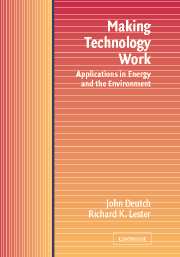Book contents
- Frontmatter
- Contents
- Preface
- 1 Introduction
- 2 Gasohol
- 3 Solar Thermal, Windpower, and Photovoltaic Technologies
- 4 Electricity from Coal
- 5 Controlling Acid Rain from Coal-fired Power Plants
- 6 Greenhouse Gases and Global Warming
- 7 Nuclear Power and Its Fuel Cycle
- 8 Managing Nuclear Waste
- 9 Nuclear Power and Weapons Proliferation
- 10 Natural Gas
- 11 Safety and Risk: Examples from the Liquefied Natural Gas and Nuclear Industries
- 12 Synthetic Fuels
- 13 Fuel Cells For Automobiles
- 14 Energy Models and Statistics
- 15 The Government's Role in Innovation
- 16 Conclusions
- Index
9 - Nuclear Power and Weapons Proliferation
Published online by Cambridge University Press: 10 December 2009
- Frontmatter
- Contents
- Preface
- 1 Introduction
- 2 Gasohol
- 3 Solar Thermal, Windpower, and Photovoltaic Technologies
- 4 Electricity from Coal
- 5 Controlling Acid Rain from Coal-fired Power Plants
- 6 Greenhouse Gases and Global Warming
- 7 Nuclear Power and Its Fuel Cycle
- 8 Managing Nuclear Waste
- 9 Nuclear Power and Weapons Proliferation
- 10 Natural Gas
- 11 Safety and Risk: Examples from the Liquefied Natural Gas and Nuclear Industries
- 12 Synthetic Fuels
- 13 Fuel Cells For Automobiles
- 14 Energy Models and Statistics
- 15 The Government's Role in Innovation
- 16 Conclusions
- Index
Summary
The discussion in the previous two chapters vividly illustrates the complexity of real world applications of nuclear reactor technology and its associated fuel cycle systems. We considered several issues that have brought this once promising technology to its knees: Economics, safety, and the environmental concerns surrounding waste management and disposal. In this chapter, we discuss the proliferation of nuclear weapons, another important problem related to the civilian use of nuclear power. Simply stated, commercial nuclear power carries with it a risk that technologies and materials from the nuclear fuel cycle will be misused for making nuclear bombs. There has been significant opposition to nuclear power on these grounds, and especially to nuclear exports to countries thought to be interested in acquiring nuclear weapons capability. In this chapter, we discuss the origin of these concerns, the history of how the proliferation issue arose, and the steps that have been taken by the international community to reduce the proliferation risks of nuclear power and, hence, to remove this obstacle to the peaceful application of nuclear technology.
Making Bombs
Nuclear fission weapons are made from either plutonium or highly enriched uranium (HEU). When a relatively small quantity of either of these materials (on the order of 10kg) is compressed by a modest amount of chemical explosives, an uncontrolled fission chain reaction can occur, releasing tremendous amounts of energy.
- Type
- Chapter
- Information
- Making Technology WorkApplications in Energy and the Environment, pp. 154 - 163Publisher: Cambridge University PressPrint publication year: 2003



